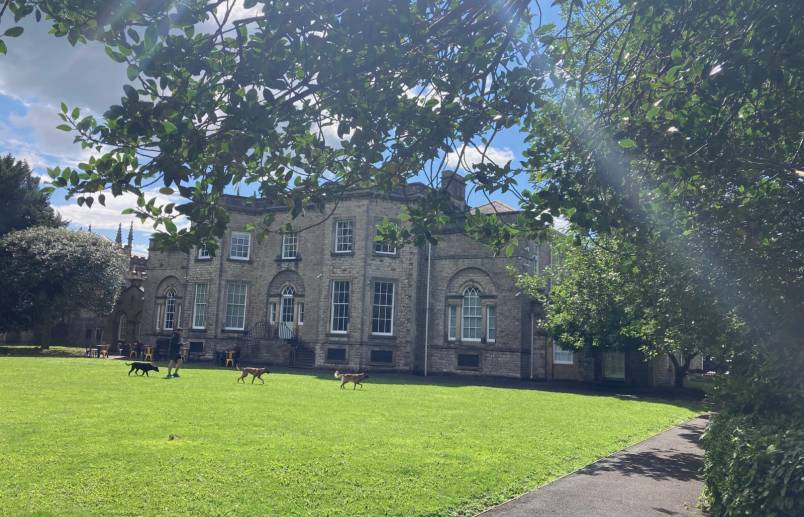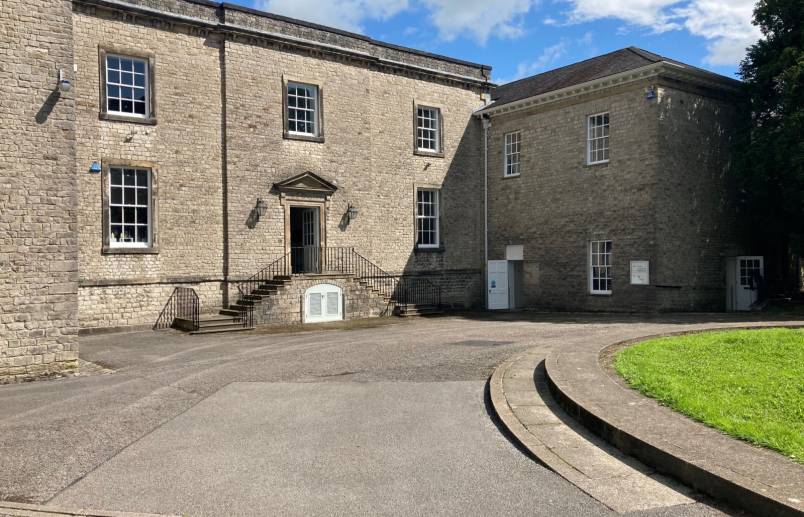CONNECTIONS
Date Posted: 7th August 2023


Went on a trip to Kendal last week to see what was happening at Abbot Hall after more than three years of closure. It is one of the best known and loved northern galleries
What a surprise and a revelation. The once dark entrance hall was full of light. For the first time in the forty years I’ve been going to exhibitions there, the shutters were open revealing the eastern view across the lawns to the River Kent. What was even more pleasing as I looked down – there were people out there sitting at tables socialising. The back door from the café has now been opened giving access to this lovely outdoor space. I don’t think the house had connected to the garden outside since it became an art gallery in the sixties.
Drawn by the light, I turned left from the hall to see Abbot Hall’s Great Picture, an impressive tryptich which fills the whole wall and tells the story of Lady Anne Clifford, a northern woman who, as a young girl, was part of the court of Queen Elizabeth 1st. She spent 30 years of her life battling for her rightful inheritance from the age of 15 when her father died. I last stood in front of that magnificent picture in February 2020 at a friend’s book launch. Christine Raafat, tells the story of this determined and liberated woman in her book The Will to Succeed. None of us at the book signing that day had the slightest inkling that the gallery would be closed for so long. The Great Picture is now flanked successfully by two contemporary portraits of two women by Charmaine Watkiss– one with a ginger flower neckpiece in the style of an Elizabethan lace collar, the other in Aloe Vera. All three of these Warrior women sit comfortably together although their stories are decades apart. They are connected.
Intrigued I crossed the hall to see what was happening in the rooms opposite with the brown furniture and 18th century paintings - I used to skip those and move on upstairs to the exhibition galleries. Drawn by a glimpse of sculpture I went in. This room is transformed. It is inviting. The whole atmosphere has changed. The dark furniture has gone and the room is full of light. It reflects a new start and a new way of thinking. Barbara Hepworth’s shimmering Moon Form takes centre stage - just as the artist liked her work to be displayed. What’s more - someone had been in the store room of the gallery’s impressive permanent collection and brought out some pieces relevant to the contemporary exhibition on show. What a lovely selection: - Auerbach, Schwitters, Piper, Wilding and Nash sitting beside JMW Turner, Wright of Derby and Romney – a curatorial triumph.
I followed the loud crashing, hissing, spitting, roaring thunderous noise I could hear in the adjoining dark room (No hushed whispers here.) This contrasting dark room is showing a powerful video of Firestack an installation on a Hebridean island by Julie Brook which shows the drama at the meeting and colliding of these elements – fire and water, sea, weather, tide. There is no escape – I was mesmerized. I was there at the heart of all the action on the large screen.
The first floor belongs to Julie Brook – a mixture of videos, installations, paintings and drawings with photographs and videos of her work in The Outer Hebrides and Japan. Julie is an internationally respected artist who enjoys creating works in inaccessible places. This exhibition is an assault on the senses. (Julie has also made an outdoor sculpture commissioned by Lakeland Arts. It is made of slate from the Brathay quarry in Ambleside which you can see at Holker Hall a few miles south of Cartmel which is worth a trip.)
This is Phase One of alterations in the building which are mainly unseen but necessary like electrics, UV glass screening, new flooring. This is a now a place people will want to visit and linger. It is inspiring and aspires to be part of the community. It is welcoming, contemporary and progressive but still paying homage to the past. It is astonishing what has been achieved on a drastically reduced budget. The £4.5 million grant that had been set aside for the project pre covid, dwindled to £615,000 in this Phase 1 of a 3 phase plan.
Top of my wish list when I set out that morning was to see what had been done about disabled access but sadly it is still not solved. I mention it so that people are aware that it is still difficult but now not impossible if determined. Abbot Hall is an 18th Century Grade 1 listed building with the main access up an ornate double Palladian staircase. Drastic modern changes have to be sympathetic to the building which is a rabbit warren of steps and stairs (some steep). To visit the exhibition rooms on the first floor without using the stairs necessitates using the ancient slow lift and two stair lifts from the car park level. This lift bi-passes the main ground floor rooms and entrance hall To get there is a bit Alice in Wonderland. It means a return to car park level and a cargo lift from the café to the main ground floor through a panel in the wall. If that sounds complex – it is. But there are people who will help you if you ask. Nothing is impossible. At least we have a major gallery back. We must use it and enjoy it.
Open Wednesday - Saturday 10am - 4pm
exhibition continues -30th December
